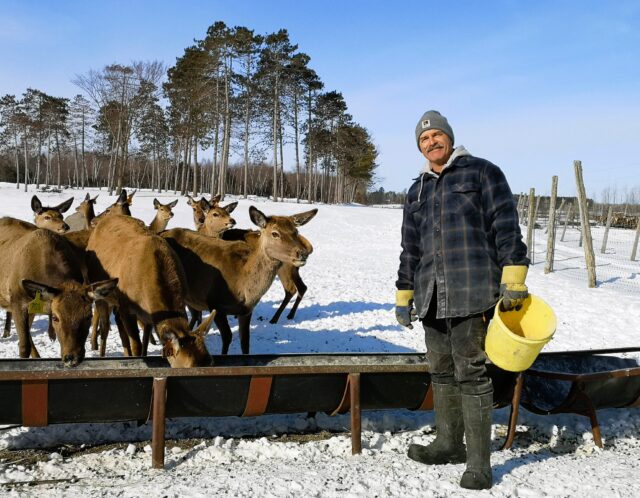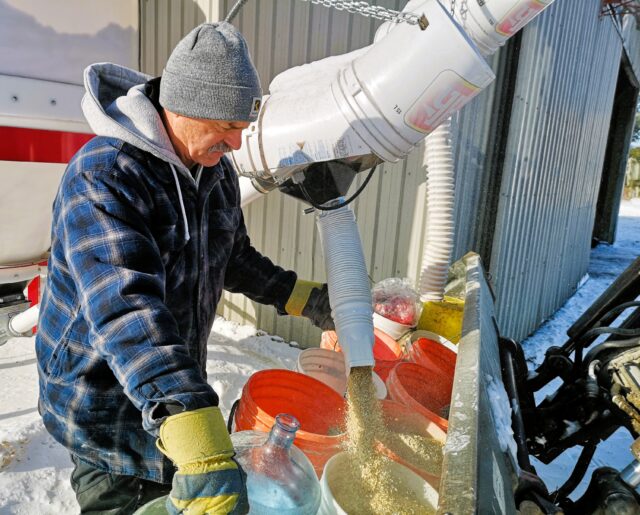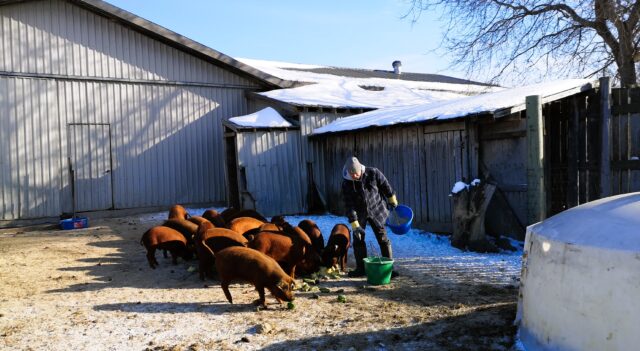Red wattles and red deer: natural farming

With his bucket loader packed with pails of animal feed, Trillium Meadows farmer Hans Lindenmann slowly navigates the steep hills and sharp turns of the snowy pathway that lead to his herds of red wattle pigs and European red deer.
It’s a piercingly sunny and bitingly cold February morning – -20C with the wind chill – and he has to knock on the pigs’ shelters to get them to venture outside for breakfast.
“The deer are fine outside all the time in this cold,” Lindenmann says. “The pigs need some encouragement to come out.”
As he cleans out their concrete feed-troughs with a shovel, the massive, shiny red-coated hogs with their wiggly wattles, or tassels, dangling from their jowls soon appear.

They’re spurred to put a bit of porcine pep in the step of their cloven hooves: Lindenmann is dumping buckets of fresh produce – heads of lettuce and other greens, peppers, apples – on the ground in their enclosure.
They scramble to munch the same food we eat: it’s a cool connection.
“I go to Ark’s Harvest in Vankleek Hill to get some of their food,” he says.
The non-profit venture and store, with locations in Hawkesbury and Cornwall, is dedicated to food security and sustainability through their food-share program.
It’s a philosophy that Trillium Meadows espouses: Lindenmann collects leftover produce that is past its prime for us but which the pigs devour greedily.
His regular trips to the store are part of Trillium’s sustainable farming and form a closed-loop food system that reduces waste.
Lindenmann grows hay elsewhere and purchases grains from local farms – Trillium Meadows is too hilly for successfully growing other crops – which he grinds for his livestock on-farm.

Hans and Marianne Lindenmann came from Switzerland in 1998 and bought the 100 acres that is Trillium Meadows. It’s just the two of them and their son who work the far
In Switzerland, Lindemann was sort of forest ranger-manager and was involved with hunting, so he knows big game and forests very well.
“When I saw I saw the deer farm here, I decided I try to buy it. It took a year to get all the permits, and we did some upgrades.”
Until a couple of years ago, Trillium Meadows raised wild boar, but across the province there was a backlash when the creatures would escape farms and do damage. The province subsequently banned raising them.
Citing that the problem was mainly in Quebec, Lindemann says his stock was always contained, but the province would have none of it. He switched to heritage pigs.
“I would have continued with wild boar because I had a huge clientele. People really liked the meat,” he says.
He and Marianne searched for a unique breed, first giving consideration to the woolly Hungarian Mangalica before settling on red wattles.
“There were four heritage vendors at one market, but nobody had red wattle,” Lindenmann says of the breed, the males of which can reach over 300 kgs.
Over his two decades in the business he’s also had to teach butchers how to make the cuts.
“I had to teach them how to separate the muscles because there are tender muscles and there are tough ones, and you don’t want them on the same steak. Now I have really good relationships with the butchers.”
For the rest of the story, visit Tribune-Express.

